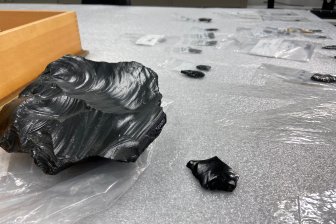A cross-border tribe is seeking funding and recognition from the Canadian government one month after opening an office in British Columbia.

In late October, the Sinixt Confederacy — part of the Washington-headquartered Colville Confederated Tribes — established itself on the second floor of a small building in Nelson, B.C.
Sinixt considers itself a transboundary tribe with rights in both the U.S. and Canada but until recently, didn’t formally exist in Canada. The Sinixt were deemed “extinct” by the government in 1956 but two years ago, that changed when the Supreme Court of Canada ruled the Sinixt Confederacy an “Aboriginal people of Canada.”
Since then, the nation has been searching for ways to formally establish itself in the province, seeking to influence the management of natural resources and make claims to government funds.
“There are a lot of different things going on in our territory that we didn’t have a lot of say in and we’re starting to get our say in,” said Jarred-Michael Erickson, a chief with the Sinixt and Colville Confederated Tribes chairman. “We’re trying to ramp that up in Canada and get a lot of our people back up there.”
But there’s a rift in those plans with pushback from several established Indigenous communities in the territory Sinixt is claiming.
The Sinixt say their territory in Canada extends from south of the U.S. border to north of Revelstoke, B.C. but that area also encompasses the traditional territory of the Sylix Okanagan, Secwépemc Nations and Ktunaxa Nations.
And disputes have already started.
The provincial government made separate bilateral deals with each community in June which will see the Sylix Okanagan, Secwépemc Nations and Ktunaxa Nations all receive 5 per cent of the revenue B.C. receives every year through the Columbia River Treaty. The Sinixt feel they have a right to dollars as well.
“Agreements with those three tribes regarding the funding that has to do with the Columbia River Treaty, we’re looking at getting some of that money coming towards us,” said Erickson. “We feel that should all come towards us, this is our area, our territory. We were forced south of the border.“
In an interview with The Globe and Mail earlier this month, Chief of the Lower Kootenay Band Jason Louie said, “They were given an inch and took 500 miles – and are basically trying to erase our existence.” And Chief of the Osoyoos Indian Band, Clarence Louie said, “It’s our territory, not theirs.”

The Sinixt have met routinely with provincial and federal ministers — both B.C Minister of Indigenous Relations and Reconciliation Murray Rankin and former Minister of Crown-Indigenous Relations, Marc Miller as they work to establish themselves in the country.
“The province, and (because this is an international issue) the federal government must get involved in this controversy,” said Rankin. “It’s not without controversy because we have other Indigenous peoples — the Okanagan Nation Alliance (Sylix Okanagan), Secwépemc Nations and Ktunaxa Nations all of whom lay claim to the area that is now the claimed area of the Sinixt.
“We’re hoping a diplomatic solution can be achieved and we’re going to work toward that end with all of our Indigenous partners.”
Erickson said that the Sinixt are working to “right a historical wrong,” and worked in collaboration with the province to complete an ethnohistorical report highlighting the tribe’s presence in the area.
“It’s a shame when your histories erased and I feel like other tribes are also trying to still erase our history,” he said.
But Erickson said he doesn’t want this to be about “intertribal fighting.”
“It’s disheartening, I guess, to hear some of those things that I’ve read and seen, so we’re trying to rebuild relationships, we’re really good neighbors.”
Looking for more Indigenous news? Find our stories here.
- Man arrested in deadly White Rock Promenade stabbing that shocked community
- Disturbing evidence admitted in voir dire hearing for B.C. man accused of killing wife
- B.C. secures 8 new middle-income housing sites for BC Builds program
- Vancouver Island teams pairing cops with mental health nurses off to encouraging start






Comments